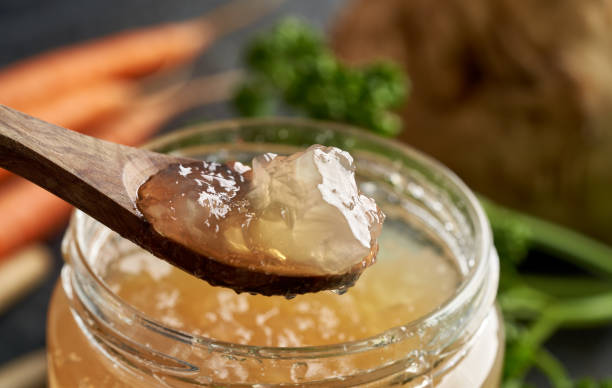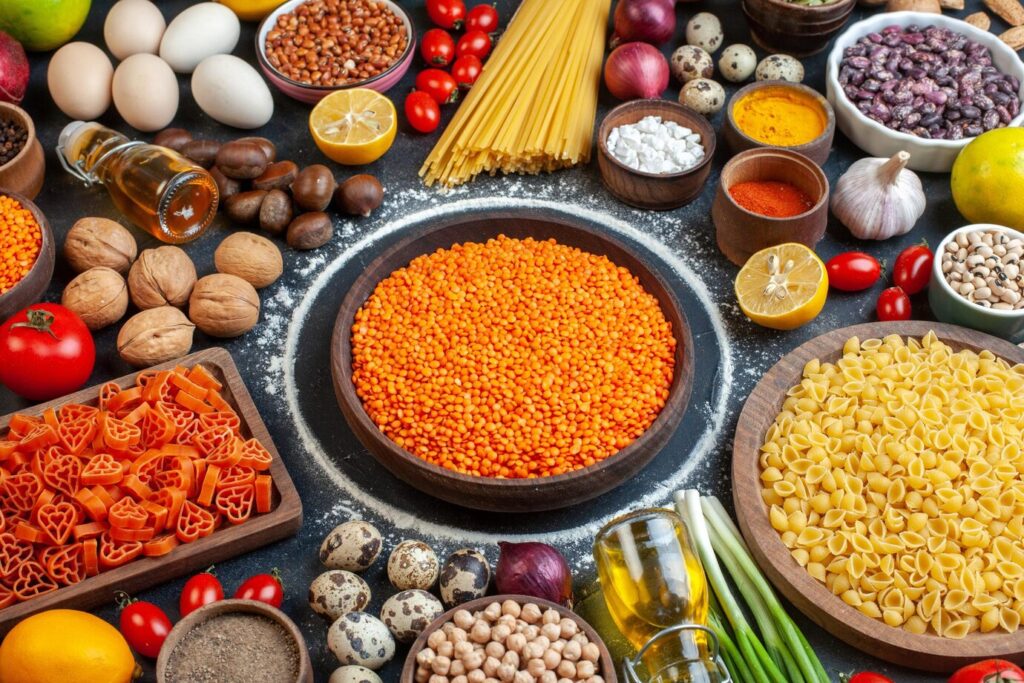Gelatin is a natural protein derived from the collagen found in the skin, bones, and connective tissues of animals, such as cows, pigs, and fish. It is a colorless, flavorless, and odorless substance widely used as a gelling agent in food, pharmaceuticals, cosmetics, and industrial products.

In the food industry, gelatin is commonly used to make jellies, gummy candies, marshmallows, and desserts. In pharmaceuticals, it is utilized for making capsules and medical formulations. It also has applications in skincare products due to its potential benefits for skin elasticity and hydration.
Gelatin is rich in amino acids like glycine and proline, which may promote joint health, digestion, and skin repair. It is available in powdered, sheet, or granulated forms and dissolves in hot water to form a gel.
Since it is animal-derived, it is unsuitable for vegetarians or vegans, but plant-based alternatives like agar-agar exist
Table of Contents
The Foundation of Well-being
Food is more than just sustenance; it’s the very foundation of our health and well-being. It provides the essential nutrients our bodies need to function optimally, grow, repair, and protect themselves from disease. However, the relationship between food and health is complex. It’s not just about what we eat but also how much we eat, how we prepare it, and how our bodies respond to different foods.
This comprehensive guide will explore these aspects, covering nutrition facts, health benefits, potential allergies and adverse effects, food varieties, optimal consumption times, storage and safety, and finally, preparation methods. Understanding these nuances is crucial for making informed dietary choices that promote overall health and vitality.
Nutrition Facts: The Building Blocks of Food
Every food item is composed of various nutrients, each playing a unique role in supporting the body’s physiological functions. These nutrients can be broadly categorized into macronutrients and micronutrients.
- Macronutrients:
- Carbohydrates: The primary source of energy for the body. They are found in grains, fruits, vegetables, and dairy products. Carbohydrates are classified into simple carbohydrates (sugars) and complex carbohydrates (starches and fibers). Complex carbohydrates are generally healthier due to their slower digestion and sustained energy release. Fiber is an indigestible carbohydrate crucial for digestive health and satiety.
- Proteins: Essential for building and repairing tissues, producing enzymes and hormones, and supporting immune function. They are found in meat, fish, eggs, dairy, legumes, nuts, and seeds. Proteins are made up of amino acids, some of which are essential and must be obtained from the diet.
- Fats (Lipids): Necessary for cell structure, energy storage, and hormone production. They are found in oils, butter, nuts, seeds, and fatty meats. Fats are classified into saturated, unsaturated (monounsaturated and polyunsaturated), and trans fats. Unsaturated fats are generally considered healthy, while saturated and trans fats should be consumed in moderation due to their potential adverse effects on heart health.
- Micronutrients:
- Vitamins: Organic compounds required in small amounts for various metabolic processes. Each vitamin has a specific function in the body. For example:
- Vitamin A: Essential for vision, immune function, and skin health.
- Vitamin B complex: Vital for energy metabolism, nervous system function, and red blood cell production.
- Vitamin C: A powerful antioxidant crucial for immune function and collagen synthesis.
- Vitamin D: Important for calcium absorption, bone health, and immune function.
- Vitamin E: An antioxidant that helps protect cells from damage.
- Vitamin K: Essential for blood clotting and bone health.
- Minerals: Inorganic substances needed for various physiological processes, such as:
- Calcium: Necessary for bone health, muscle contraction, and nerve function.
- Iron: Crucial for red blood cell production and oxygen transport.
- Potassium: Important for fluid balance, nerve function, and muscle contraction.
- Magnesium: Essential for muscle function, nerve function, and blood sugar control.
- Zinc: Supports immune function, wound healing, and cell growth.
- Vitamins: Organic compounds required in small amounts for various metabolic processes. Each vitamin has a specific function in the body. For example:
- Water: Essential for numerous bodily functions, including hydration, nutrient transport, and temperature regulation. It is not a macronutrient or micronutrient but is vital for life.
- Other Important Components:
- Phytochemicals: Bioactive compounds found in plants that have antioxidant, anti-inflammatory, and other health-promoting properties.
- Enzymes: Biological catalysts that speed up chemical reactions in the body, playing a critical role in digestion and other metabolic processes.
Health Benefits: Beyond Basic Nutrition
The health benefits of food extend far beyond providing basic nutrition. A balanced and nutritious diet can:

- Prevent Chronic Diseases: A healthy diet can significantly reduce the risk of chronic diseases, including heart disease, type 2 diabetes, certain types of cancer, and obesity.
- Boost Immunity: Nutrients like Vitamin C, Vitamin D, Zinc, and antioxidants strengthen the immune system, making the body more resilient to infections and diseases.
- Improve Mental Health: Foods rich in omega-3 fatty acids, B vitamins, and antioxidants can support brain health, improve cognitive function, and reduce the risk of mood disorders.
- Enhance Digestive Health: Fiber-rich foods promote regular bowel movements, prevent constipation, and support a healthy gut microbiome.
- Maintain Healthy Weight: A balanced diet, combined with regular exercise, can help maintain a healthy weight and prevent obesity.
- Increase Energy Levels: Foods rich in complex carbohydrates and protein provide sustained energy, combating fatigue and improving overall performance.
- Promote Healthy Skin, Hair, and Nails: Nutrients like Vitamin A, Vitamin E, Biotin, and collagen support healthy skin, hair, and nail growth.
- Support Bone Health: Calcium and Vitamin D are essential for maintaining strong and healthy bones, reducing the risk of osteoporosis.
Allergies: Understanding Adverse Reactions
Food allergies are adverse reactions mediated by the immune system. When someone with a food allergy consumes the offending food, their immune system identifies specific proteins in that food as harmful and mounts an immune response. This response can trigger a wide range of symptoms, varying from mild to life-threatening.
- Common Food Allergens: The most common food allergens include:
- Milk
- Eggs
- Peanuts
- Tree nuts
- Soy
- Wheat
- Fish
- Shellfish
- Symptoms of Food Allergies: Symptoms can range from mild to severe, including:
- Skin reactions like hives, itching, and eczema
- Digestive issues like nausea, vomiting, diarrhea, and abdominal pain
- Respiratory symptoms like wheezing, coughing, and shortness of breath
- Swelling of the face, lips, tongue, or throat
- Dizziness or lightheadedness
- Anaphylaxis: A severe, life-threatening allergic reaction that can cause a drop in blood pressure, difficulty breathing, and loss of consciousness.
- Diagnosis of Food Allergies: Food allergies are diagnosed through:
- Skin prick tests
- Blood tests (specific IgE antibody tests)
- Oral food challenges (performed under medical supervision)
- Elimination diets (where specific foods are removed from the diet and then reintroduced to identify triggers).
- Management of Food Allergies:
- Strict avoidance of the offending food is the primary strategy for managing food allergies.
- Epinephrine auto-injectors (EpiPens) are crucial for treating anaphylaxis and should be readily available for individuals with severe allergies.
- Medical consultation with an allergist or immunologist is essential for proper diagnosis and management.
Adverse Effects: Beyond Allergies
Adverse effects of food go beyond allergic reactions. They encompass various negative health outcomes associated with consuming specific foods or excessive quantities of certain nutrients.
- Food Intolerances: These are non-immune-mediated reactions that can cause digestive discomfort. They do not involve the immune system. Common intolerances include lactose intolerance, gluten sensitivity, and sensitivity to certain food additives.
- Toxicity: Some foods can be toxic if consumed in excessive amounts or if improperly prepared. Examples include:
- Uncooked kidney beans: Contain toxins that can cause nausea, vomiting, and diarrhea.
- Certain types of fish: Can accumulate high levels of mercury or other toxins.
- Some wild mushrooms: Can be poisonous.
- Nutrient Overconsumption: Excessive intake of certain nutrients, such as Vitamin A, Vitamin D, and iron, can lead to toxicity and adverse health effects.
- Unhealthy Eating Habits: Poor dietary choices, like excessive consumption of processed foods, sugary drinks, and unhealthy fats, can contribute to weight gain, chronic diseases, and other negative health outcomes.
Varieties: The Diversity of Food
Food comes in a vast array of varieties, each with its unique nutritional profile, flavor, texture, and origin. Understanding this diversity is key to making informed food choices.

- Fruits: Categorized into citrus fruits, berries, tropical fruits, and more. Each fruit offers a unique blend of vitamins, minerals, fiber, and antioxidants.
- Vegetables: Can be classified into leafy greens, root vegetables, cruciferous vegetables, and more. They are excellent sources of vitamins, minerals, fiber, and phytochemicals.
- Grains: Include whole grains (like brown rice, quinoa, and oats) and refined grains (like white rice and white flour). Whole grains are generally healthier due to their high fiber content.
- Proteins: Found in animal sources (meat, fish, eggs, dairy) and plant sources (legumes, nuts, seeds). Each offers a different amino acid profile.
- Dairy: Includes milk, yogurt, cheese, and other dairy products. They are good sources of calcium and protein, but also contain saturated fats.
- Oils and Fats: Found in various plant-based and animal-based sources. Choosing healthy fats like olive oil, avocado oil, and nut oils is important.
When It’s Best: Optimal Timing for Food Consumption
The timing of food consumption can impact digestion, energy levels, and overall health.
- Timing of Meals:
- Breakfast: A nutritious breakfast is crucial to kickstart metabolism and provide sustained energy for the day.
- Lunch: A balanced lunch helps maintain energy levels and focus throughout the afternoon.
- Dinner: A light dinner, consumed a few hours before bedtime, is best to avoid digestive discomfort during sleep.
- Timing of Specific Foods:
- High-fiber foods: Best consumed earlier in the day, as they can be difficult to digest close to bedtime.
- High-protein foods: Can be included in any meal but are especially beneficial post-exercise.
- Sugary foods: Should be consumed sparingly and avoided before bedtime to prevent energy crashes and sleep disturbances.
- Ayurvedic Perspective on Timing:
- Ayurveda emphasizes eating meals at regular times that align with your body’s natural rhythms.
- Lunch should be the largest meal, as the digestive fire (Agni) is at its peak during midday.
- Eating a light dinner early in the evening is recommended for better digestion and sleep.
Storage and Food Safety: Protecting Food Quality
Proper storage and food safety practices are essential to prevent foodborne illnesses and preserve the nutritional value of foods.
- Proper Storage Techniques:
- Refrigeration: Perishable foods should be stored in the refrigerator at temperatures below 40°F (4°C).
- Freezing: Food can be stored in the freezer at temperatures below 0°F (-18°C) for extended periods.
- Pantry Storage: Dry goods should be stored in airtight containers in a cool, dry, and dark place.
- Food Safety Practices:
- Handwashing: Always wash your hands with soap and water before handling food.
- Proper Cooking Temperatures: Cook foods to the proper internal temperatures to kill harmful bacteria.
- Avoiding Cross-Contamination: Use separate cutting boards and utensils for raw and cooked foods.
- Proper Thawing: Thaw frozen foods in the refrigerator, microwave, or cold water, not at room temperature.
- Checking Expiration Dates: Pay attention to expiration dates on food products and discard expired items.
How to Prepare: Maximizing Nutritional Value
The way food is prepared can significantly impact its nutritional value and potential health benefits.
- Cooking Methods:
- Steaming: A healthy cooking method that preserves nutrients.
- Baking: Can retain nutrients but may also involve the use of oils or fats.
- Boiling: Can cause some nutrients to leach into the water.
- Grilling: Can lead to the formation of harmful compounds if foods are overcooked.
- Frying: Can add excess calories and unhealthy fats, reducing nutritional value.
- Minimizing Processing: Choosing fresh and minimally processed foods can ensure maximum nutrient intake.
- Smart Food Combinations:
- Combining iron-rich foods with Vitamin C-rich foods can enhance iron absorption.
- Adding healthy fats to vegetable-rich dishes can improve absorption of fat-soluble vitamins.
- Mindful Eating: Practicing mindful eating—paying attention to hunger cues, savoring your food, and eating slowly—can improve digestion and enhance your overall eating experience.
Conclusion: The Informed Path to Nourishment
Food is a powerful tool that can either promote health or contribute to disease. By understanding the nutrition facts, potential benefits, risks, best times, storage requirements, safety protocols, and best preparation methods, we can make informed choices that support our overall well-being. It’s crucial to adopt a holistic view, focusing not only on what we eat but also on how we eat and how we listen to our bodies. Ultimately, the key to a healthy relationship with food lies in balance, moderation, awareness, and respect for the profound impact that food has on our lives.
also on how we eat and how we listen to our bodies. Ultimately, the key to a healthy relationship with food lies in balance, moderation, awareness, and respect for the profound impact that food has on our lives.
FAQs About Gelatin, Dietary Restrictions,
- What is gelatin made from?
- Gelatin is a protein derived from collagen, a natural protein found in the skin, bones, and connective tissues of animals. The process involves boiling these parts to extract the collagen, which is then processed to form gelatin.
- Is gelatin vegetarian?
- No, gelatin is not vegetarian because it is derived from animal sources, specifically from the collagen found in the skin, bones, and connective tissues of animals. Therefore, it is also not vegan.
- जिलेटिन किस चीज से बनता है?
- जिलेटिन एक प्रोटीन है जो जानवरों की त्वचा, हड्डियों और संयोजी ऊतकों में पाए जाने वाले कोलेजन से प्राप्त होता है। इस प्रक्रिया में कोलेजन निकालने के लिए इन भागों को उबाला जाता है, जिसे बाद में जिलेटिन बनाने के लिए संसाधित किया जाता है।
- Which animal is gelatin made from?
- Gelatin is typically made from the collagen of pigs and cows. However, it can also be derived from fish, although less common. The specific animal source often depends on the manufacturer and regional availability.
- What is pig gelatin called?
- Pig gelatin is simply called gelatin, though it’s typically understood that if no specific animal is mentioned, it’s often derived from pigs or a mixture of pigs and cows. There isn’t a separate specific name for pig gelatin.
- Is gelatin good for health?
- Gelatin does offer some health benefits due to its collagen content. It may support joint health, improve skin elasticity, and strengthen hair and nails. However, it is not a complete protein, and its benefits can often be obtained from other sources. As gelatin is not a complete protein, it should not be relied upon for providing essential nutrients.
- Why is gelatine bad?
- Gelatin isn’t inherently “bad,” but it may be undesirable for certain individuals for several reasons. It may be unsuitable for vegetarians and vegans due to its animal origin. Also, some people might have concerns about the ethical implications of consuming animal products. Furthermore, its health benefits can be obtained through alternative sources, so it is not necessary for overall health.
- Who cannot eat gelatin?
* Those who cannot consume gelatin include:
* Vegetarians and vegans: Due to its animal origin.- Those with religious restrictions: Some religions prohibit the consumption of certain animal products.
- How to make gelatin at home?
- Making gelatin at home is a complex process that involves extracting collagen from animal bones and tissues. It’s not recommended for home cooks due to the time, complexity, and safety concerns involved. It’s more practical to purchase gelatin powder or sheets.
- Can Hindus eat gelatin?
- Whether Hindus can eat gelatin depends on individual beliefs and practices. Some Hindus may avoid gelatin derived from beef or pork, especially those who adhere strictly to a vegetarian diet. Many Hindus may consume gelatin, especially if it is not derived from beef or pork. The view on gelatin is varied among Hindus.
- Can Hindus eat pork?
- Generally, many Hindus avoid beef due to the cow being considered a sacred animal. However, pork consumption is not explicitly forbidden in Hinduism, though some followers may still choose not to eat it. It depends on individual beliefs and cultural practices.
- Can Muslims eat gelatin?
- The permissibility of consuming gelatin in Islam depends on its source.
- If gelatin is derived from halal-slaughtered animals like cows, it is considered halal, even if the collagen extraction process has altered its original form.
- If gelatin is derived from pork or non-halal slaughtered animals, it is considered haram (forbidden) by most Muslims. Many Muslims seek gelatin from bovine or plant based sources such as agar agar.
- Why do Muslims not eat pork?
- The prohibition of pork consumption in Islam is based on religious teachings in the Quran. Muslims believe that pork is considered unclean and unhealthy.
- Is gelatin Halal?
- Whether gelatin is Halal depends on its source.
- Gelatin from animals slaughtered according to Islamic law is halal.
* If gelatin is sourced from pork or animals not slaughtered according to Halal guidelines, it is considered haram.
* Plant based gelatin sources such as Agar Agar are also Halal.
- Can Muslims eat gelatin?
- As with the question of whether gelatin is Halal, it depends on the source. If the gelatin comes from a Halal source (such as beef from a Halal slaughtered animal or plant based sources), then it is permissible to consume by Muslims. If the gelatin source is Pork, or a non Halal slaughtered animal, then the gelatin is considered Haram.
- Is gelatin used in ice cream?
- Yes, gelatin is sometimes used in ice cream. It acts as a stabilizer, improving texture and preventing the formation of ice crystals. However, not all ice cream brands use gelatin.
- Is marshmallow vegetarian?
- Traditional marshmallows are not vegetarian because they typically contain gelatin. However, some vegetarian or vegan marshmallows are made using plant-based alternatives to gelatin, like agar-agar or carrageenan.
- Is kwality walls ice cream vegan?
- Most Kwality Walls ice cream products are not vegan as they are made with dairy ingredients. However, they may offer a few vegan options, so it is important to check specific labels.
- What are the ingredients in Amul ice cream?
- Amul ice cream typically contains milk solids, sugar, stabilizers, emulsifiers, and flavoring agents. Some varieties may contain added vegetable oils. You need to check the specific product label for a detailed list of ingredients.
- What is Kwality ice cream made of?
- Kwality ice cream typically contains milk solids, sugar, stabilizers, emulsifiers, flavoring agents, and may sometimes contain vegetable oils. Specific ingredients vary by flavor and product line so it’s important to check the specific product label.
- What are the ingredients in Cornetto butterscotch?
- Cornetto Butterscotch typically contains milk solids, sugar, vegetable oil, butterscotch flavoring, stabilizers, emulsifiers, and edible food colors. Specific ingredients can vary. Always check the packaging for the most accurate information.
- Does Havmor use palm oil?
- Havmor has some product lines that contain palm oil. Palm oil is often used in ice cream as a fat source that contributes to texture. You need to consult specific product labels for accurate information.
- What is 100% real ice cream?
- In the ice cream industry, “100% real ice cream” usually refers to ice cream that is made primarily with milk and cream as fat sources, without the inclusion of vegetable oils as fat replacers. This definition may vary by region.
- What are the ingredients in Kwality vanilla ice cream?
- Kwality Vanilla ice cream typically contains milk solids, sugar, stabilizers, emulsifiers, flavoring agents, and may sometimes contain vegetable oils. Always check the product label for accurate ingredients.
- What is McDonald’s ice cream made of?
- McDonald’s soft-serve ice cream primarily consists of milk, sugar, cream, and stabilizers. The ingredients can vary across different products and regions, so it is best to check product packaging or the restaurant’s website for specific details.
- Which ice cream is very costly?
- Some ice cream brands that are known to be expensive include Häagen-Dazs, Ben & Jerry’s (certain limited editions), and premium artisanal ice cream brands that use high-quality ingredients and unique production processes.
- Is Havmor ice cream made of milk?
- Yes, Havmor ice cream is primarily made using milk. However, some product lines may also include vegetable oils for fat content. It is important to check each label for accurate ingredients.
- Does Arun ice cream use palm oil?
- The usage of palm oil varies between different product lines of Arun ice cream. You need to check specific product labels for accurate information on the usage of palm oil.
- What is the old name of Havmor ice cream?
- The old name of Havmor ice cream was originally “Havmor Ice Cream Factory.”
- Is kwality walls ice cream made of milk?
- Yes, most Kwality Walls ice cream products are primarily made using milk. However, some product lines may include vegetable oils as a fat source.
- Which ice cream brand is best in India?
- The ‘best’ ice cream brand is subjective and depends on personal taste and preferences. However, some popular and widely consumed ice cream brands in India include Amul, Havmor, Kwality Walls, and Mother Dairy.
